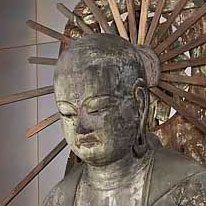Past Exhibitions
- Japanese Sculpture
- October 9, 2021 - December 5, 2021
All visitors must purchase a special exhibition ticket to enter the museum during the special exhibition period. There are no separate exhibitions of the permanent collection during this period.
From ancient times through the Edo period (1615–1868), almost all subjects of Japanese sculpture were religious in nature. After Buddhism was introduced to Japan and became firmly established in the seventh century, the production of Buddhist statues flourished. Buddhist deities and their images
often have origins in South Asia or Central Asia, and they were usually transmitted to Japan by way of China, bringing with them a complex array of foreign influences.
One of the distinctive characteristics of Japanese sculpture is its use of wood as a primary material. Various modes of carving and other techniques—including joint-block construction (yosegi-zukuri) and inlaid crystal eyes—were developed in Japan to create these wood images.
Over time, the repeated introduction of new images from the Asian continent contributed to further stylistic transformations and innovations in Japan. The Japanese Buddhist sculptures on view here reflect various styles of different historical periods.












